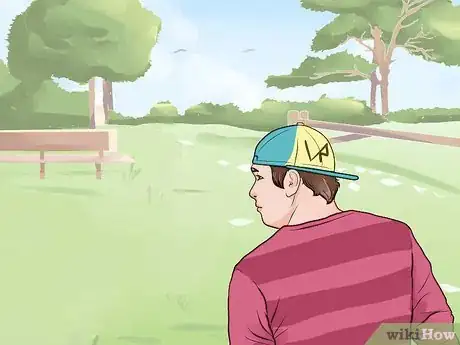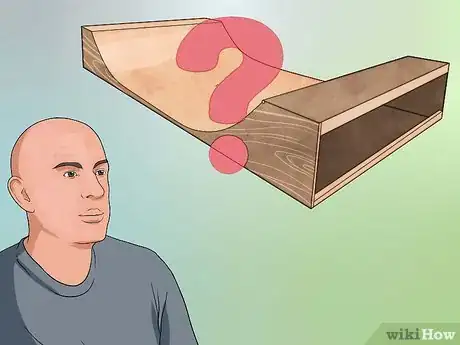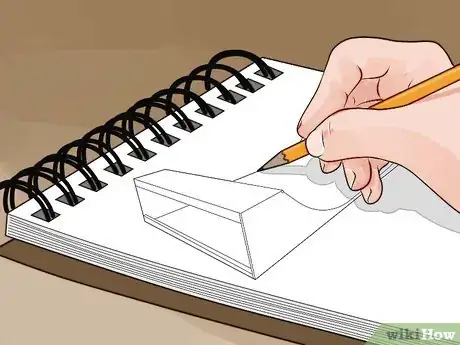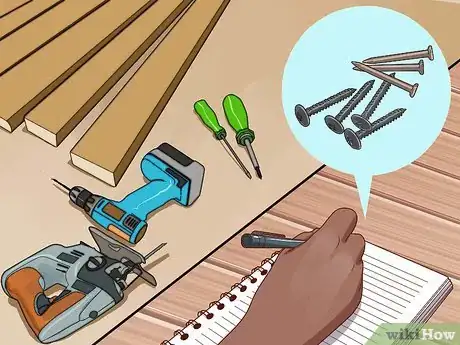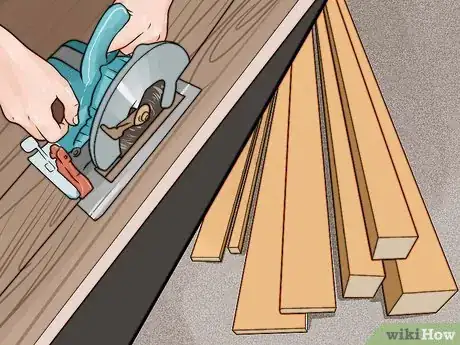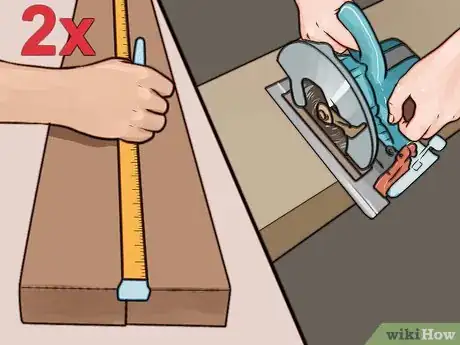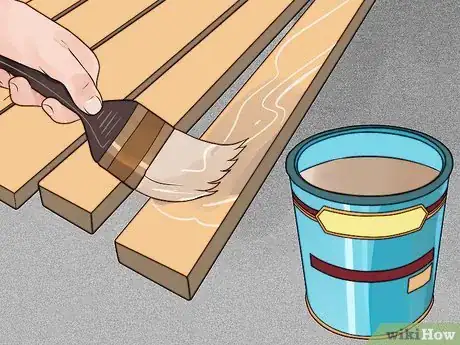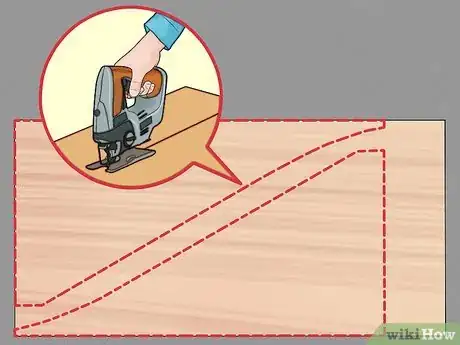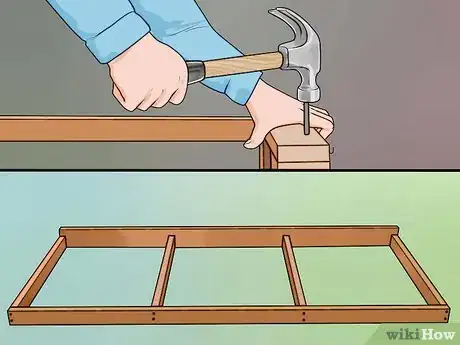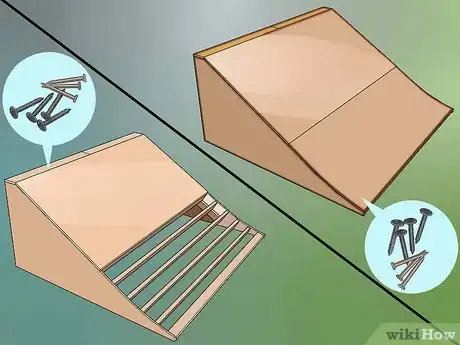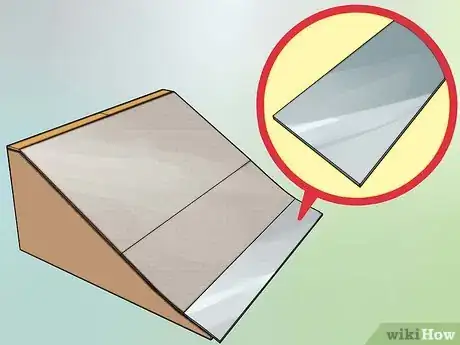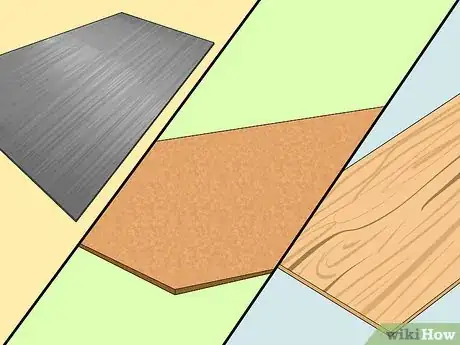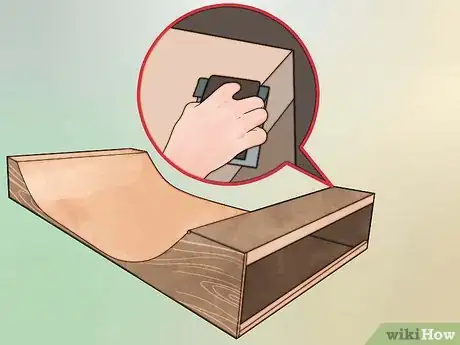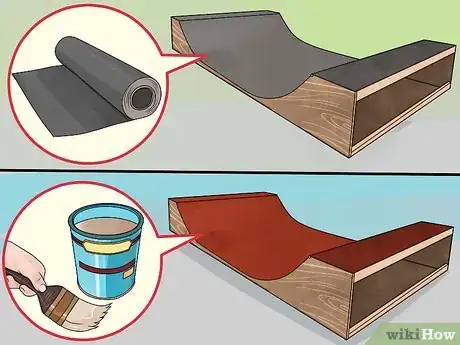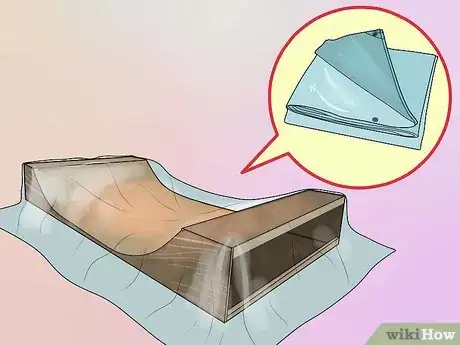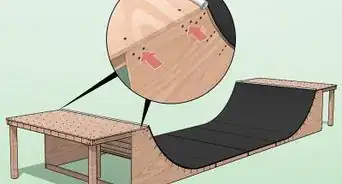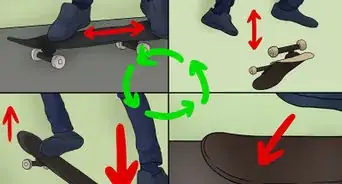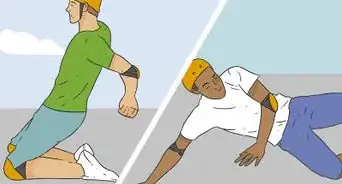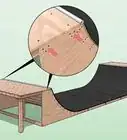This article was co-authored by Sam Hubbard. Sam Hubbard is a Professional Carpenter and the Owner of Hubbard Carpentry and Remodeling. He has over 19 years of experience in the industry. Sam specializes in kitchen remodels, home woodworking, cabinetry, and handyman services.
There are 12 references cited in this article, which can be found at the bottom of the page.
This article has been viewed 440,173 times.
Whether you’re a seasoned skateboarder or trying to raise one, building a skate ramp can be a fun and satisfying experience when done right. Maximizing space, keeping safe, and staying patient are keys to creating this fun investment.
Steps
How to Design Your Ramp
-
1Maximize all available space. Take a look at the space you have available not only for when the ramp is in use but also when it’s not. If you choose to build a portable ramp, make sure you take into consideration any storage issues. Conversely, you may not want to build a ramp if your yard doesn’t have adequate surrounding area for other activities.
- The first thing you have to consider is where will you place your ramp when it is in use. Consider the terrain, if there are any obstructions, and if there are any issues that may arise with your neighbors or the city. Depending on how large you plan to make your ramp, your place of residence may have ordinances on measurements or noise so it’s best to check with anyone you may think will be affected.
- Consider what happens when your ramp is not in use. For example, will you need to store it and, if so, how will you transport it to and from different locations. If you don’t plan to store it, how much more resources will you have to spend in order to keep it maintained. Most likely you will have it outdoors so you have to consider how weather will affect its use. Moreover, when left outside, will it prevent you and your family from utilizing that space for anything else other than skateboarding.
- Some common places to use a skate ramp are the driveway, carport, and backyard.
- Ramps can be stored in the open when properly lifted off the ground, sealed and covered with a tarp. Increase your ramp’s longevity by shielding it from the elements
-
2Decide what kind of ramp you want to build. Once you’ve got a good sense of the space available to you, plan out how involved you want your ramp to be. Whether you’re a beginner or an expert creating new tricks, the possibilities are endless.
- Don’t be nearsighted. Just because you may only be focused on a single trick now doesn’t mean you won’t want to learn new ones. Try to keep your ramp as versatile as possible; however, start small if this is your first woodworking project.
- A small mini ramp is good for a limited amount of space and can be built into any shape. A ramp strictly for jumps can be limiting but is great for beginners. A standard ramp conventionally has ten foot transitions, a small staircase and can be used in millions of different ways as you hone your craft.[1]
Advertisement -
3Create a blueprint to customize your design. Getting your ideas on paper is the best way to get a sense of how involved this project will be. It will also allow you to work out any practical issues concerning measurements.
- Find pro ramp plans online.
- Don’t buy expensive design software. Look for free blueprints online, consult friends skilled in design, or go to your local hardware store to start you off on the right foot.[2]
- Don’t be afraid to be creative with your design; however, be sure not to start building unless you’re truly satisfied with the final design. Repeatedly starting and stopping can bleed your resources and cause unwanted frustration.
- When you’re customizing, some experimentation may be needed but be careful not to act without intention. For example, if you experiment and hastily cut off several feet rather than an inch at a time, you may need to start the entire project all over again. This can especially be true when building curved ramps.[3] If you’re on a budget or a beginner, pick a blueprint that matches most of your needs and, after a successful build, consider building a second ramp with customization.
How to Organize Supplies
-
1Make a list of what you need. Use your blueprint as a guide for what tools are needed. Consult your local hardware store in case they have better alternatives. For example, certain types of wood may provide a better surface for skateboarding but may not hold up well to the autumn rain.[4]
- Purchase screws and wood at any hardware store. Ensuring the length and type are best suited for your measurements and plans.
- Consider renting, borrowing, or using your own power tools to reduce time. For example, a power drill with assorted bits would be helpful but not necessary if you just want to use a regular screwdriver. Likewise, a jigsaw would also reduce time if you are cutting any wood down.
- If you choose steel plating in conjunction with wood or instead of it, you’ll need to find a local steel fabricator or scrap metal centre in your area. This may be difficult to find in your area, so start your design and customization around what steel is available to you.
- Stick to a budget especially if this is your first build. A beginner ramp commonly costs approximately $200 to build after all building materials are purchased but this can easily sky rocket if you factor in power tools, customization, or top-of-the-line materials.[5]
-
2Organize your lumber. While some stores will cut it for you, be prepared to shape your wood to your specifications yourself. Getting a professional will save you time and the hassle of working with power tools so weigh that possibility into your overall budget to help manage your expectations.
- Use pressure treated wood. This material is chemically treated for protection against the growth of mould and is fairly waterproof. Consult the retailer for all possible alternatives.[6] Pressure treated wood comes in two colors: a copper green-ish tinge and a natural tone. The only difference is the preservative so choose whatever looks best to you. [7]
-
3Measure twice and cut once. Before cutting or shaping anything, remember the old adage.[8]
- If you’re unsure, do a faux set-up by drawing it out because it’s better to make the mistake on paper rather than ruin your project and start over. Don’t be afraid to ask someone for help.
- Don’t be embarrassed about mistakes. You might need to pick up extra pieces of wood, but don’t give up because woodworking is a skill that needs to be developed over time.
-
4Keep safe. Safety should be your number one priority both when in the process of building your ramp and for the final outcome, when your ramp is in use.
-
5Preserve the wood to ensure your ramp’s longevity. Wood won’t last forever, so protect it with a skate-friendly sealant such as Skatepaint, which is a polyurethane sealant that protects from water. [11]
- Protect your ramp from rain and the elements by giving it a smooth finish with sealant.
How to Build Your Ramp
-
1Cut out the sides of the ramp. Initially, you’ll be cutting out two side pieces from plywood. These will be flimsy but will be the outer sides of the ramp.[12]
- Use a pencil to draw out the lines and a jigsaw to cut along these lines if you haven’t had your wood cut at the hardware store.
-
2Frame the ramp. Starting with the back support, nail in the four supports found in the blueprint. Be generous with your nails because each nail adds more support to the ramp. After all four supports are attached securely, line up the second side and secure it into the bottom of the supports.[13]
- Attach the sides of the ramp to a front anchor. It’s vital to make sure, at this point in time, that the frame is level because if it’s not level now, it won’t be after completion.
-
3Put in the ramp supports. Starting at the top, attach your 2x6 and 2x4 eight inches apart, with the 2” side facing up. Attach the 2x6 first, as the removed length from the 2x4 will help maintain a ramp that is flush to the ground. [14]
- You can also double up on the 2x6 boards approximately four inches from the top of the ramp for additional support for the ramp.
- You can also attach a support (two longer 2x4) underneath the 2x6’s because, while it's unlikely they will break, the added support will truly strengthen the structure.[15]
-
4Attach the remaining plywood. Take the two 4” x 6” and place them atop the highest 2” x 6”. This gives your ramp a short but safe edge to stand on. After nailing securely, take your two plywood sheets and attach the upper one first. After it’s securely attached with screws, attach the lower sheet. The bottom sheet should slightly overhang the ramp to create a smooth transition from the ramp to the pavement.[16] Remember to drill the screws from the top down to prevent anything from catching, making the ramp unsmooth.[17]
- Put screws in every foot starting at the top to ensure a smooth transition between panels.
-
5Create the surface of your ramp. Take two sheets of masonite or sheets of skatelite and lay them down atop the previous sheets of plywood. [18] This will be the finished, exposed top of the ramp. After careful alignment, secure them in by using screws approximately every six to eight inches. Remember to start at the top and always screw down into the ramp.
- If possible, don’t put the seam of the masonite or skatelite directly atop the seam of the two plywood boards in order to add strength to the ramp.
-
6Attach the steel plate to the bottom of the ramp. When drilling steel, use a drill bit to first drill a hole for the screw. Next, drive in the screw. this will help ensure the screws are flush with the metal. [19]
How to Surface Your Ramp
-
1Choose the top layer. The first two layers should be ⅜” untreated plywood but the top layer can be Skatelite, Masonite, or you can simply skate directly on Plywood. Choose the top layer based on your budget and climate.[20]
- Skatelite is the most costly surface as it is used by professionals and is weather resistant.
- Masonite is a smooth tempered hardboard that is reasonably priced but is not resistant to the sun and rain so it must be protected.
- Plywood is not weather resistant and is unforgiving when you fall but is the most cost effective choice for your surface.
-
2Sand down any jagged edges or loose corners. This particularly needs to be done when just using plywood. Plywood comes in different grades depending on the quality. The quality of the plywood indicates its durability. Plywood is made up of layers and each layer is given a grade. For example, the first letter is the grade of the top layer while the second letter is the grade of the bottom layer.[21]
- For a smooth finish, sand down the bare wood using 120 sandpaper. Follow that up with 150 grit. Then work your way up to 180 grit.
- Grade A is the highest grade of plywood with no knots, splits, or cracks.
- Grade B is solid with minimal knots and splits. It usually is sanded smooth but may need you to give it another sanding.
- Grade C has knots up to 1 ½” in diameter as well as cracks and splits that affect the wood’s integrity.
- Grade D will have many splits and cracks. Knots can be as large as 3” and the surface will need to be sanded. Grade D is the lowest grade but the most cost effective.
- Finnish Birch is high quality plywood but is expensive and may be difficult to find.
-
3Finish the surface of your ramp. Whether you are using the highest quality skatelite or more cost effective plywood, always protect your material from the weather.
- Skatelite is resistant from the sun and rain but laying tar paper underneath it will protect the plywood base from any water that gets in through any cracks.[22]
- If you’re using masonite or plywood, protect your surface from the rain with water resistant paint. Use Spar Urethane or Polyurethane Paint. Spar Urethane is the most heavy duty but also the most costly. Polyurethane does not protect as well as Spar Urethane but comes in a variety of colours.[23]
-
4Cover your ramp with a tarp to give it an extra layer of protection. Be sure to shovel off any snow during the Winter to make sure the moisture doesn’t seep through and warp your wood.
Community Q&A
-
QuestionI was thinking of using marine plywood for the top layer. What is your advice?
 Community AnswerIt weathers better, for sure. Just keep in mind that pressure-treated wood will leave a nasty infection if you get a splinter.
Community AnswerIt weathers better, for sure. Just keep in mind that pressure-treated wood will leave a nasty infection if you get a splinter. -
QuestionCould I use wood I found in a recycling dumpster?
 Community AnswerYes, you can, as long as it isn't super cracked of rotted.
Community AnswerYes, you can, as long as it isn't super cracked of rotted. -
QuestionHow do I fix kinks in a mini ramp?
 Community AnswerYou have two options. First, you can take out the surrounding screws, let the wood relax, and screw it back down. Alternatively, you can add an extra joist under the kink and screw into it.
Community AnswerYou have two options. First, you can take out the surrounding screws, let the wood relax, and screw it back down. Alternatively, you can add an extra joist under the kink and screw into it.
Warnings
- Never use nails on the riding surface. This is very dangerous!⧼thumbs_response⧽
- Don’t start building until you are satisfied with your design and it fits within your budget and timeline. Avoid costly mistakes and unwanted headaches by managing your expectations.⧼thumbs_response⧽
- As with any extreme sport, be sure you have a safe location and quality safety equipment.⧼thumbs_response⧽
- Be aware of the quality of the material that you use. For a good wood jump don't get any pieces of wood that have huge holes where you'll ride. If it's rotten in spots, it will make for bad jumps and potential injury.⧼thumbs_response⧽
- Always wear a helmet when jumping!⧼thumbs_response⧽
- Don’t use drugs or alcohol when building because this can impair your judgement and even the slightest mistake can lead to a terrible injury.[25]⧼thumbs_response⧽
Things You'll Need
- Open space for jumping, preferably a flat, paved area.
- Blueprint for your ramp.
- Wood in various measurements corresponding to your blueprint (ex: 2x4's, 2x6’s, 4x6’s).
- Sheets of plywood.
- Hammer
- Screws (coated for pressure treated wood if you use pressure treated wood)
- Nails
- Level or straight edge.
- Pencil/marker for design.
- Screw Driver
- Saw
- Masonite
References
- ↑ http://www.dansworld.com/faq.html#RAMPBUILD
- ↑ http://diyskate.com/ramps.html
- ↑ http://www.diyskate.com/launch_01.html
- ↑ http://www.diyskate.com/bank_01.html
- ↑ http://www.diyskate.com/bank_01.html
- ↑ http://www.homedepot.com/c/discover_benefit_pressure_treated_wood_HT_BG_LC
- ↑ http://www.homedepot.com/c/discover_benefit_pressure_treated_wood_HT_BG_LC
- ↑ https://www.psychologytoday.com/us/blog/got-minute/201202/measure-twice-cut-once/
- ↑ https://wiki.artisansasylum.com/index.php/Basic_woodshop_safety_rules
- ↑ https://wiki.artisansasylum.com/index.php/Basic_woodshop_safety_rules
- ↑ https://ocramps.com/ramp-plans/
- ↑ http://www.diyskate.com/bank_01.html
- ↑ http://www.diyskate.com/bank_01.html
- ↑ http://www.diyskate.com/bank_01.html
- ↑ http://www.diyskate.com/bank_01.html
- ↑ http://www.diyskate.com/bank_01.html
- ↑ http://www.diyskate.com/bank_01.html
- ↑ http://www.diyskate.com/bank_01.html
- ↑ http://www.diyskate.com/bank_01.html
- ↑ http://www.xtremeskater.com/ramp-plans/faqs/
- ↑ http://diyskate.com/info_wood.html
- ↑ http://www.xtremeskater.com/ramp-plans/faqs/
- ↑ http://www.xtremeskater.com/ramp-plans/faqs/
- ↑ http://www.dansworld.com/ramp_faq.html
- ↑ http://www.woodworkweb.com/woodwork-topics/woodworking-safety/262-the-10-safety-rules-every-woodworker-needs-to-know.html
About This Article
To build a skateboard ramp, you’ll need screws, plywood, and a top layer like Masonite or Skatelite. Power tools aren’t necessary but will make the process much easier. Measure the space where you want the ramp to go so you know how big to make it. A small ramp is great for beginners, but a standard ramp with 10-foot transitions and a small staircase will be more useful in the long term. Building your ramp involves cutting out the sides and back from plywood, then screwing slats on top to support the main plywood surface. Finish the surface with a top layer like Skatelite to waterproof the ramp. Alternatively, use Masonite and finish it with water-resistant paint. For more tips, including how to draw a blueprint for your skateboard ramp, read on!
